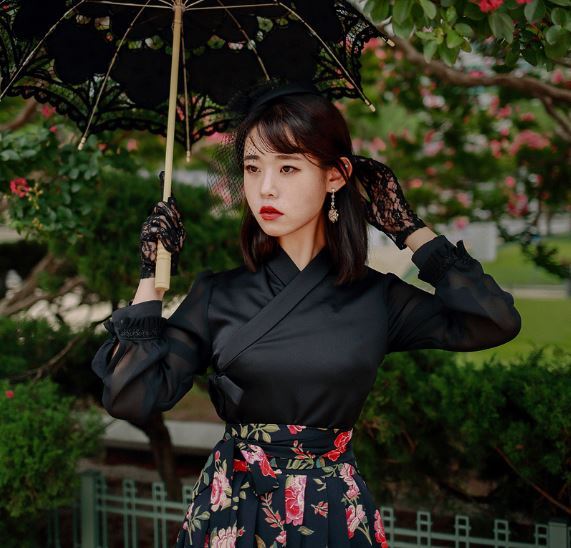[Video] Modernized hanbok setting trend, reinterpreting tradition
By Choi Ji-wonPublished : Nov. 6, 2018 - 16:33
Korean traditional costume, hanbok, is a powerful trend not only in its homeland but also on the global stage. K-pop stars such as BTS and the K-drama “Mr. Sunshine” have played a part in spreading the beautiful garments around the world.
Here in Seoul, a “hanbok tour” still tops the to-do lists of many domestic and foreign tourists. Hanbok tours of the capital became a sensation in 2013, when the city government began offering free admission to its ancient palaces, such as popular landmarks Gyeongbok Palace and Changdeok Palace, for people in hanbok. The policy was a great success, and the number of inbound tourists wearing hanbok has skyrocketed since then.
Yet in line with hanbok’s growing popularity, voices of concern have grown louder questioning the authenticity of the hanbok on Seoul’s streets. They complain of loud, flashy designs not in keeping with Korean fashion in the early 20th century. Or the presence of ribbons, sheer fabric and garments of the wrong proportions or sizes.
Here in Seoul, a “hanbok tour” still tops the to-do lists of many domestic and foreign tourists. Hanbok tours of the capital became a sensation in 2013, when the city government began offering free admission to its ancient palaces, such as popular landmarks Gyeongbok Palace and Changdeok Palace, for people in hanbok. The policy was a great success, and the number of inbound tourists wearing hanbok has skyrocketed since then.
Yet in line with hanbok’s growing popularity, voices of concern have grown louder questioning the authenticity of the hanbok on Seoul’s streets. They complain of loud, flashy designs not in keeping with Korean fashion in the early 20th century. Or the presence of ribbons, sheer fabric and garments of the wrong proportions or sizes.
Most tourists rent their hanbok from local shops, basing their choices on a garment’s visual appeal. For some, it seems, “the fancier, the better.” They may not give much thought to whether the design is true to the original hanbok concept. To add to the irony, most rental shops import Korean hanbok that have been manufactured in China.
The controversy over “inauthentic” versions of hanbok was recently reignited after the mayor of Jongno-gu, the Seoul district that is home to three of the ancient palaces, called for an end to the free passes for visitors wearing “distorted versions” of hanbok. “Why should we provide benefits for clothing styles that are not even ours?” mayor Kim Young-jong asked in September during a discussion on “wearing our traditional costume properly.”
So what is it that makes a hanbok “traditional”? What standards should an ensemble have to meet to be considered a true hanbok?
Apparently, not even hanbok experts have an answer. Park Sun-young, hanbok promotion director of the Hanbok Advancement Center, says it is difficult to draw a clear line differentiating a traditional hanbok from a modernized one. She suggests that the best approach is to include “nonstandard” hanbok within the broader category of hanbok, as wearing either one is a way of showing appreciation for Korean culture.
Kwon Miru of Hanbok Traveler also stresses the positive aspects of the hanbok sensation. Hanbok Traveler is a group of young people who wear hanbok in their everyday lives -- wherever they go -- as a way to enjoy and promote the traditional garments. Kwon, one of its founding members, began wearing hanbok in her everyday life in 2013, when doing so was considered “weird” among the general public.
“Those of us wearing hanbok often faced hostile reactions back then,” Kwon recollected. “I can feel the attitude toward hanbok has really changed in five years,” she said. “But this does not mean that we are losing our tradition. We are actually getting back in touch with tradition.”

Lee Ji-eon, the CEO of modern hanbok brand Happly, strives for a balance between style and tradition. Lee also started off as a mere admirer of the classic garment. When she managed a small hanbok boutique as a college student, she became intrigued with the period of Korean history when Western culture first began to have an influence -- that is, the early 20th century. She created Happly to harmonize Korean and Western fashion.
“Happly is doubling its profits every year,” she said. “The number of foreign customers is also increasing, and this shows that hanbok is not just something we should keep to ourselves.”
When asked about her major goals, Lee answered, “I hope hanbok can be adopted into the popular fashion in various ways -- just as kimono-style jackets and Chinese-collared shirts have.”
By Choi Ji-won (jwchoikr@heraldcorp.com)









![[Kim Seong-kon] Democracy and the future of South Korea](http://res.heraldm.com/phpwas/restmb_idxmake.php?idx=644&simg=/content/image/2024/04/16/20240416050802_0.jpg&u=)








![[KH Explains] Hyundai's full hybrid edge to pay off amid slow transition to pure EVs](http://res.heraldm.com/phpwas/restmb_idxmake.php?idx=652&simg=/content/image/2024/04/18/20240418050645_0.jpg&u=20240418181020)

![[Today’s K-pop] Zico drops snippet of collaboration with Jennie](http://res.heraldm.com/phpwas/restmb_idxmake.php?idx=642&simg=/content/image/2024/04/18/20240418050702_0.jpg&u=)